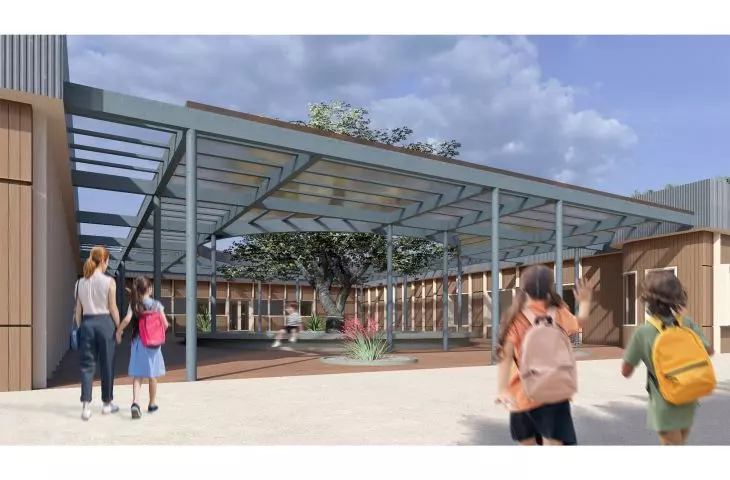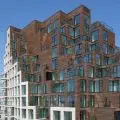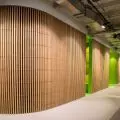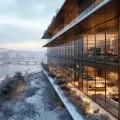Graduates of the Faculty of Architecture at the West Pomeranian University of Technology - Patrycja Migała and Filip Bielecki - have designed a universal kindergarten on Cukrowa Street in Szczecin, a response to the problems faced by parents when choosing an appropriate facility. The young architects' model project takes into account the needs of children and their psychophysical development.
view of the kindergarten area
© Patrycja Migała and Filip Bielecki
design
The introduction to the work was an analysis of the history and current status of the subject of kindergarten design. A number of sites from communist-era Poland and contemporary ones were examined, as well as European kindergartens representing often innovative approaches. The results of the analysis indicated a lack of clear and consistent guidelines for the design of such facilities.
The creators of the project attached particular importance to the creation of an open space, conducive to the integration of children. Play takes place outside the classrooms, with no division into age groups, which encourages joint play and the development of interests. The main place for integration is the corridor, which has been adapted for the implementation of various games and activities.
corridor play area
© Patrycja Migała and Filip Bielecki
functionality
Thanks to the introduction of large sliding doors between the rooms and the opening of the multifunctional room to four sides, it is possible to extend the play space and adapt it to the organization of additional activities and events, including those unrelated to the work of the kindergarten. The kindergarten is equipped with a dining room, located next to the kitchen section, which can accommodate 40 children at a time.
multifunctional room
© Patrycja Migała and Filip Bielecki
The basic variant is designed for six preschool sections, and its functions are laid out in an H-shape. The building is characterized by a clear division of functional blocks, arranged around a centrally located corridor. The building can be essentially divided into two parts: one exclusively for children, and the other consisting of a catering block with a dining room and an administrative and technical block.
3D cross-section
© Patrycja Migała and Filip Bielecki
The facility was adapted to the scale of a child, thanks to the differentiation of levels. The children's section was founded 50 cm higher, making it lower. The building was founded on a foundation slab. The design includes protruding windows, which act as shaping elements on the facade and a furniture function in the interior.
Vegetative layers were introduced on the roof to compensate for the green area built up by the building. The kindergarten has been lit from above with skylights, which increases the versatility of the design and allows it to be located in areas with different light levels.
main hallway
© Patrycja Migała and Filip Bielecki
construction
The building'sstructure was designed in a timber frame system, which is assumed to reduce investment costs and shorten construction time, as well as enable the use of sustainably sourced materials. In addition, the architects were keen to create a space for children, allowing them to create a play area on their own, which promotes their development. Toys and furniture were designed to be versatile and encourage creativity, without suggesting specific games and solutions. To regulate the access of light to the rooms, movable light breakers were introduced, they find their extension on the facade.
kindergarten room
© Patrycja Migała and Filip Bielecki
variance
In accordance with the plan envisaged for the area, both an independent kindergarten facility in the basic variant and a second one, complementing the school complex, were presented. Comprehensive landscaping, including a garden, was also designed for the selected site, and access and service to the facility were included.
garden
© Patrycja Migała and Filip Bielecki
Theentrance lot is an extremely important part of the identification of this type of building. A covered courtyard was created as a meeting place for children and parents around a centrally located apple tree, which for children is an element of preschool identity - it is their tree.
A corridor connects all parts of the building and allows children to go out to the garden. Lockers and washrooms are located in this part, which allows for efficient changing and going outside and maintaining hygiene upon return.
view of the entrance part - covered courtyard
© Patrycja Migała and Filip Bielecki
The rhythmic facade has been enriched with functional elements, such as benches, flower pots and climbing walls, making it possible to vary it.
The scheme of the facility's functioning is intended to be simple and intuitive, evoking in children a sense of security and belonging to the preschool community. Every child will find his or her place here.
view of the facade with a bench and flower pot
© Patrycja Migała and Filip Bielecki
In the corridor space there is a separate zone of tranquility, intended for children who may feel temporarily overwhelmed by an excess of stimuli and emotions. The halls have their own color identification, and the color palette adopted in the project is consistent and unobtrusive. The halls have separate areas for play, learning, a kitchenette, a bathroom and a storage room. All equipment is lightweight, modular and allows easy rearrangement of interiors.
preschool room
© Patrycja Migała and Filip Bielecki
modular system
Themodularity of the building allowed the creation of several basic combinations based on simple geometry - a broken variant, a reduced four-unit variant and a double variant. In addition, a storied var iant was designed, which combines compact dimensions with high capacity. Two staircases and two elevators were placed in the corridor. The staircase not only serves a communicative function, but has also become an integral aesthetic element thanks to its wooden cladding.
3D cross-section of the first-floor variant
© Patrycja Migała and Filip Bielecki
Theplayground was divided into sections, providing access to different activities. The surfaces and their heights were varied, and the space was enriched with a fruit and vegetable garden, which would also be tended by children. In addition, shade trees, ladders and other play elements were placed in the square.
playground
© Patrycja Migała and Filip Bielecki









































































